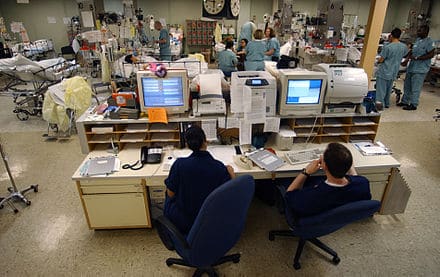A report from the Healthcare Cost and Utilisation Project lists the 20 conditions responsible for almost 50% of total aggregate hospital costs in 2013, with 35.6 million hospital stays costing a total of $381.4bn (£312bn). Expenditure on hospital care, which makes up the largest proportion of total health care spending, increased by 3.5% in 2013. The figures represent the cost to the hospital to provide the care – not the cost paid by the service users – and do not include associated physician costs.
Top ten:
1. Septicaemia
6.2% of total hospitalisation costs, or $23.66bn, was spent on this serious complication.
2. Osteoarthritis
Osteoarthritis was found to be the second most costly condition in the same year. Although the cost was 30% less than for the most expensive condition, this still amounted to $16.52bn.
3. Live-born
The total costs of live births in 2013 was $13.29bn.
4. Complications associated with grafts, implants or devices
This was listed as the fourth most costly inpatient condition at $12.43bn.
5. Acute myocardial infarction
Heart attacks cost only marginally less than the costs associated with complications, totalling $12.09bn in 2013.
6. Congestive heart failure.
At $10.22bn, congestive heart failure is one of the top ten most expensive conditions.
7. Spondylosis, intervertebral disc disorders and other disorders affecting the back
These are extremely common and resulted in hospital stays amounting to $10.22bn.
8. Pneumonia
A common condition that puts the most vulnerable at risk, pneumonia-related hospital inpatient costs were $9.5bn.
9. Coronary atherosclerosis
This is becoming increasingly common, as evidenced by the growing costs associated with the condition. In 2013, these costs were $9bn.
10. Acute cerebrovascular disease
Including stroke, transient ischaemic attack (TIA), subarachnoid haemorrhage and vascular dementia, the costs totalled $8.84bn.
Costs are increasing not only as a result of higher user numbers but also as a result of research, clinical trial services and advances in medical services and procedures. Clinical trial services are an integral aspect of healthcare.
Conditions 10-20:
Cardiac dysrhythmias – $7.18bn; adult respiratory failure – $7.08bn; surgical complications – $6.08bn; rehabilitation care – $5.37bn; mood disorders – $5.25bn; bronchiectasis and chronic obstructive pulmonary disease – $5.18bn; heart valve disorders – $5.15bn; diabetes mellitus – $5.14bn; fracture of femur – $4.86bn; biliary tract disease – $4.72bn.

